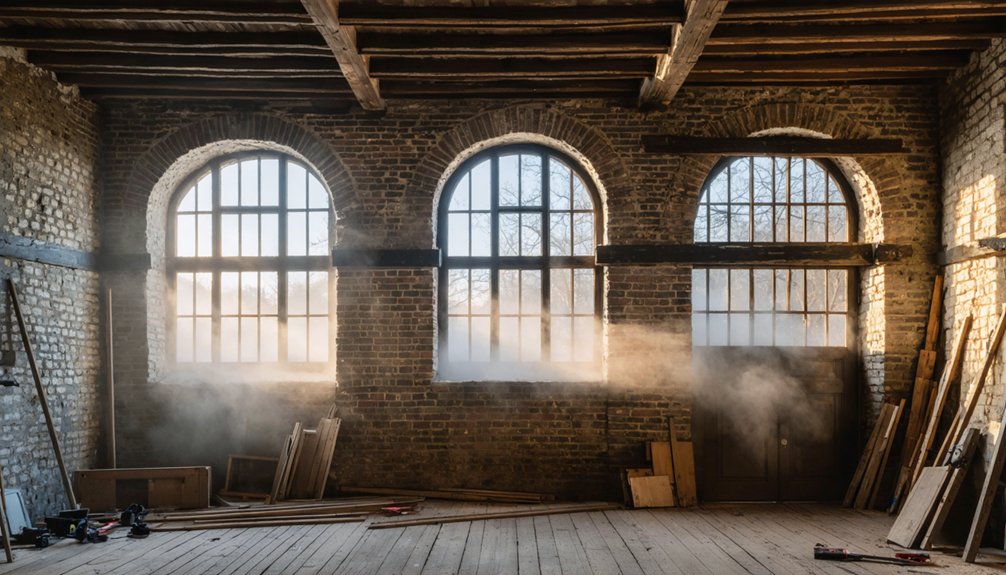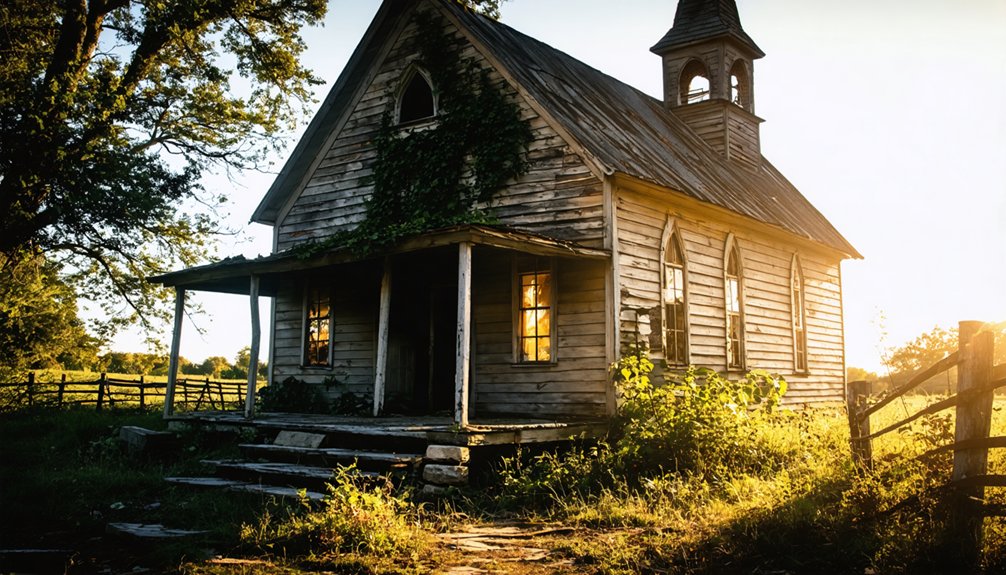Preserving colonial ghost towns requires five key strategies: create digital archives through 3D mapping technology; mobilize community volunteers for sustainable maintenance; establish dedicated funding mechanisms through grants and partnerships; conduct thorough archaeological research for historical accuracy; and implement arrested decay techniques that stabilize rather than restore structures. You’ll achieve authentic preservation by combining high-tech documentation with traditional conservation methods, while engaging local communities in protecting these irreplaceable historical treasures. These approaches form the foundation of effective heritage management.
Key Takeaways
- Implement arrested decay techniques that stabilize rather than restore structures, preserving authenticity while preventing complete collapse.
- Create comprehensive digital archives using 3D mapping technology to document sites with millimeter precision for future reference.
- Establish dedicated funding mechanisms with diversified revenue streams including grants, endowments, and public-private partnerships.
- Mobilize community volunteers through structured programs that provide training in archaeological methods and historical preservation techniques.
- Use compatible, traditional materials for repairs while monitoring environmental factors that affect deterioration rates.
Creating Digital Archives Through 3D Mapping Technology
As colonial ghost towns face inevitable deterioration from both natural elements and human interference, the implementation of 3D mapping technology offers unprecedented opportunities for extensive digital preservation.
You can now capture these fragile historical sites with millimeter-precise accuracy using integrated approaches that combine laser scanning and photogrammetry.
Modern 3D scanning techniques create exhaustive digital documentation without physical contact, preserving artifact integrity while generating detailed records suitable for analysis and restoration planning.
Smartphone-based workflows using apps like PIX4Dcatch enable you to rapidly document sites—capturing thousands of images in minimal field time.
These technologies produce multi-resolution models that document everything from intricate interior surfaces to broader structural elements, ensuring nothing is lost to time.
The resulting digital archives become permanent records of cultural heritage that might otherwise disappear forever, while simultaneously enabling virtual tourism experiences that bring these historic sites to audiences worldwide.
Similar to the Polonnaruwa UNESCO World Heritage Site documentation project, these techniques can generate comprehensive floor plans, sections, and elevations of ghost town structures for future reference.
Mobilizing Community Volunteers for Sustainable Preservation
While colonial ghost towns require significant professional intervention, the strategic mobilization of community volunteers often determines the ultimate success of preservation initiatives.
Begin your volunteer recruitment through local heritage organizations and historical societies, establishing clear roles from artifact processing to site interpretation. The Jamestown Rediscovery volunteer program has successfully engaged participants in Fort Site Interpretation since 1995.
Implement structured skill development programs featuring on-site training in traditional craftsmanship, archaeology techniques, and artifact handling. These build both competence and dedication to your preservation mission.
Community engagement flourishes when you involve residents in public tours and workshops that showcase the site’s historical significance. Creating a dedicated website with discussion boards can strengthen community connections and facilitate ongoing dialogue about preservation efforts.
Maintain robust retention strategies by recognizing contributions, offering flexible scheduling, and creating continuous feedback channels.
Establish formal registration systems and pre-arrival information packets to properly manage your volunteer force.
Establishing Dedicated Funding Mechanisms for Long-Term Restoration
Successful preservation of colonial ghost towns depends fundamentally on establishing robust and diversified funding mechanisms that can withstand economic fluctuations over decades.
Your restoration efforts should prioritize matching grants, which typically range from $2,500 to $150,000 depending on the program, while requiring your community to contribute financially—enhancing local investment and accountability.
Prepare compelling grant applications for programs like National Trust Preservation Funds, focusing on planning and educational components.
Develop funding partnerships with private foundations and corporations to create stable revenue streams.
For emergency situations that threaten your site’s historical integrity, consider applying for out-of-round funding through the National Trust Preservation Funds program.
Consider establishing an endowment or dedicated trust fund to guarantee continuous financial support for preservation activities.
Document your preservation process thoroughly with detailed records of all restoration work to maintain historical accuracy and support future maintenance efforts.
Advocate for supportive policy changes at state and local levels, including tax incentives that encourage private investment in your ghost town’s restoration while maintaining regular financial reviews to demonstrate accountability to stakeholders.
Conducting Archaeological Research for Historical Accuracy
Effective archaeological research forms the bedrock of historically accurate colonial ghost town preservation.
You’ll need to establish clear historic contexts through interdisciplinary approaches that incorporate both public input and scholarly expertise.
Begin by integrating archival evidence with material records—historical documentation provides essential insights into settlement patterns while complementing artifact analysis findings.
Implement standardized research methodologies across multiple sites to enable meaningful comparative analysis.
Document topographical features and structural remains with precision, including dimensions, materials, and spatial relationships.
Mission archives and land grant documentation often reveal how populations maintained cultural practices during colonial shifts.
The strategic position of colonial ports like College Landing provides valuable information about how economic activities shaped community development and trade networks.
When gaps in knowledge emerge, focus your documentation efforts on specific data needs and relevant property types that will strengthen your preservation narrative while ensuring authentic representation of the site’s colonial heritage.
Implementing Arrested Decay Techniques to Maintain Structural Integrity
Implementing arrested decay techniques represents a fundamental shift from traditional restoration approaches, as you’ll be working to stabilize structures rather than return them to their original condition.
Begin with thorough condition surveys to identify vulnerable areas and active decay mechanisms before any intervention occurs. These assessments provide essential baseline data for monitoring effectiveness over time.
Apply consolidation techniques selectively, using compatible materials like lime-based mortars that strengthen fragile elements without compromising historical integrity. Consider implementing similar application techniques to those used in SDF treatment, which can effectively arrest decay processes without invasive procedures. Consider installing barriers and implementing regular patrols to protect against intentional vandalism that could undermine your preservation efforts.
Make certain all treatments remain breathable and reversible whenever possible. Control environmental factors by improving drainage, managing vegetation, and installing protective coverings where necessary.
Remember that your goal is to slow deterioration while maintaining authenticity—preserving the site’s character and patina as evidence of its journey through time.
Frequently Asked Questions
How Do Seasonal Climate Variations Affect Preservation Timelines?
Seasonal climate variations accelerate your preservation challenges, forcing you to lengthen timelines as wetting-drying cycles, temperature fluctuations, and extreme weather events intensify climate impact on structural integrity and materials.
What Legal Permissions Are Needed From Original Property Owners?
Ah, you’ve stumbled upon the ultimate freedom quest—property rights! You’ll need written consent from verified titleholders after thorough title searches, as land use permissions absolutely govern your legal right to preservation activities.
You can achieve historic authenticity with modern alternatives when they match visual properties, undergo scientific testing, and meet preservation standards while clearly documenting where they’ve replaced original components in your reconstruction work.
How Are Preservation Priorities Determined When Multiple Structures Require Attention?
In a world where every brick tells a thousand stories, you’ll prioritize structures based on historical significance, imminent threats, funding sources, and community involvement—balancing preservation needs against available resources and stakeholder values.
What Security Measures Protect Sites From Vandalism and Artifact Theft?
You’ll find vandalism deterrents include surveillance technologies, physical barriers, and community stewardship programs, while artifact monitoring employs tamper-resistant displays, digital documentation, and environmental sensors to prevent theft and damage.
References
- https://thesecretlifeofmarbles.com/ghost-town-marbles/
- https://dc.etsu.edu/cgi/viewcontent.cgi?article=3427&context=etd
- https://ghosttownclub.org/preservation/
- https://en.wikipedia.org/wiki/Historic_preservation
- https://jme.shahroodut.ac.ir/article_2948.html
- https://en.wikipedia.org/wiki/Ghost_town
- https://www.forestsociety.org/property/monson-center
- https://virginialiving.com/culture/colonial-williamsburgs-quest-to-preserve-historic-trades/
- https://www.swyvl.io/blog/preserving-the-past-the-critical-role-of-3d-mapping-in-cultural-heritage
- https://files.eric.ed.gov/fulltext/ED304386.pdf



